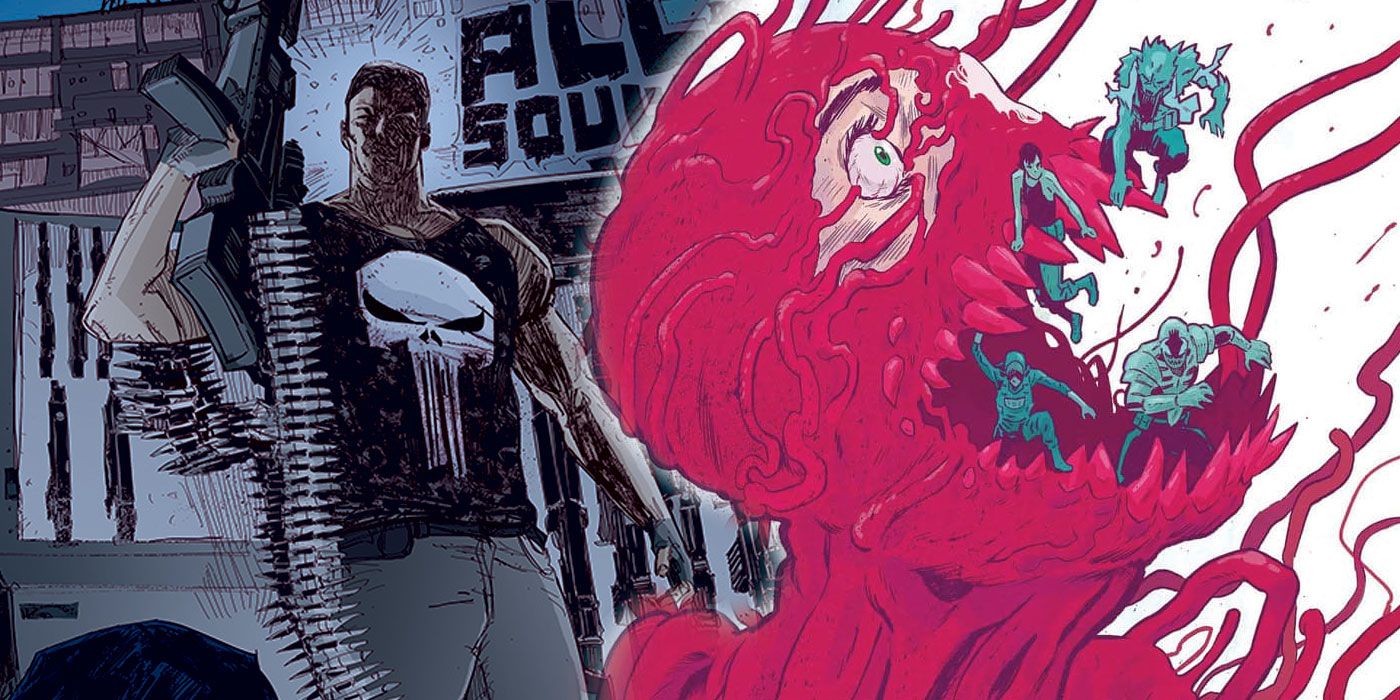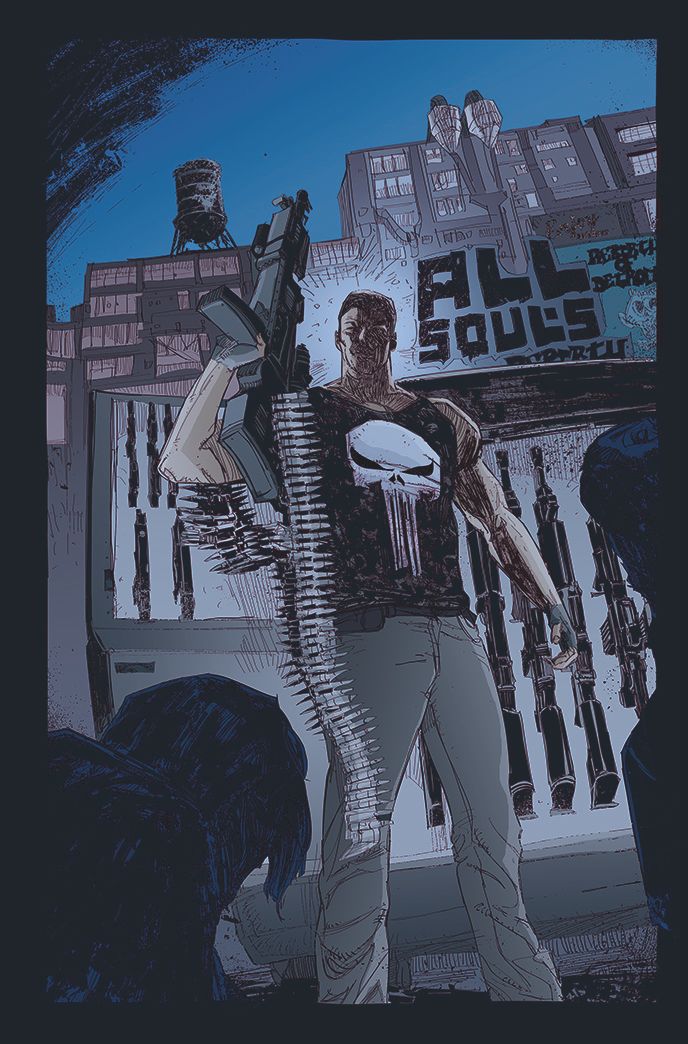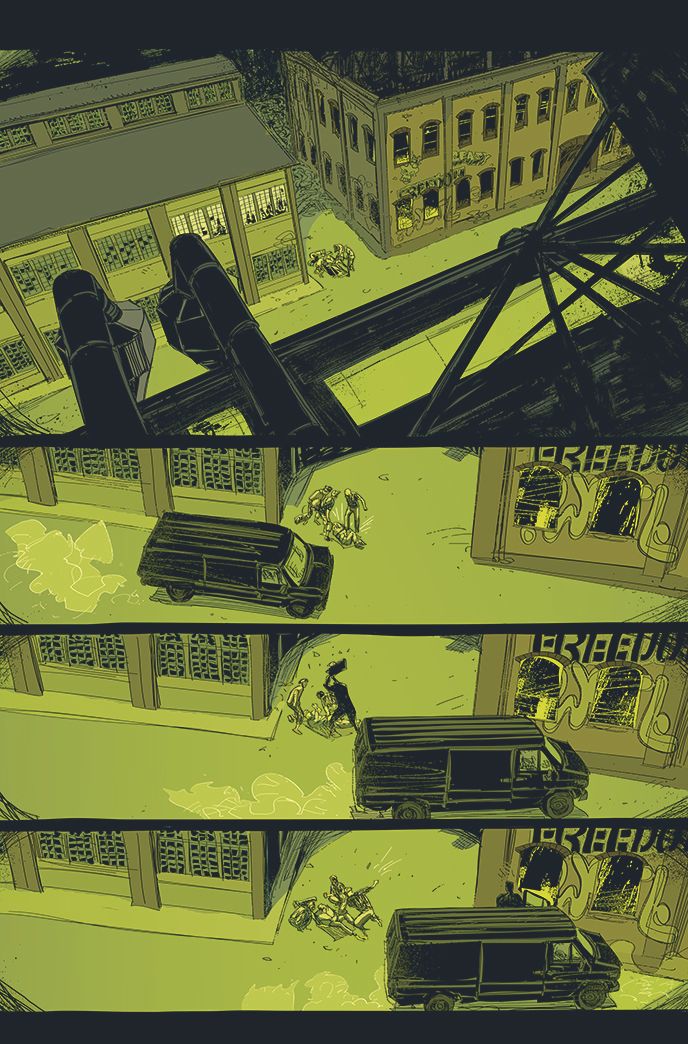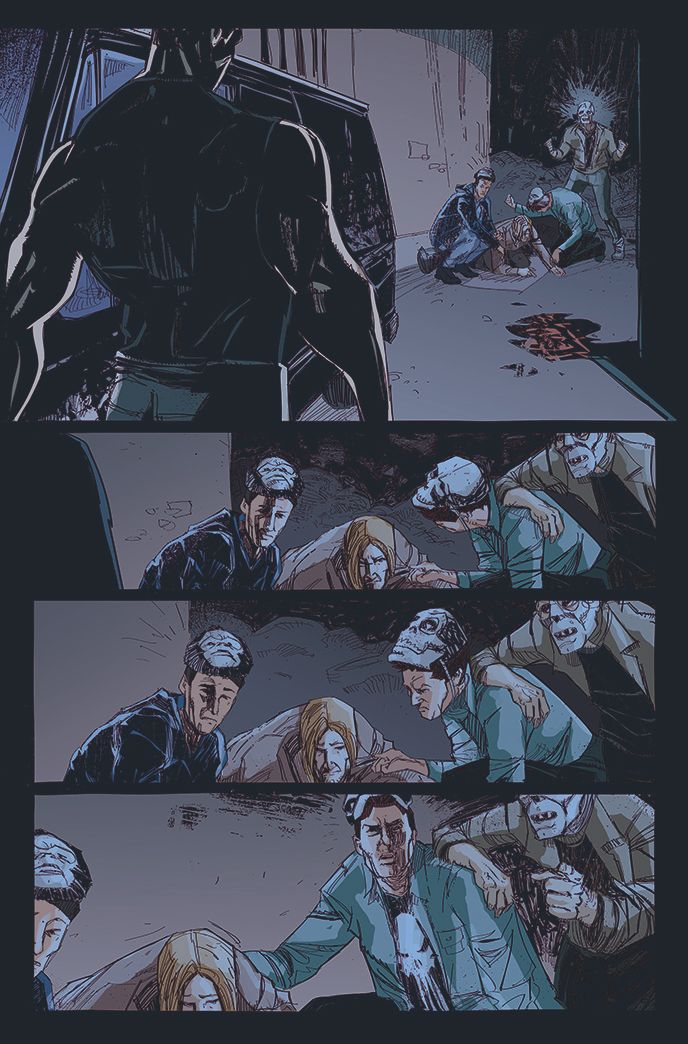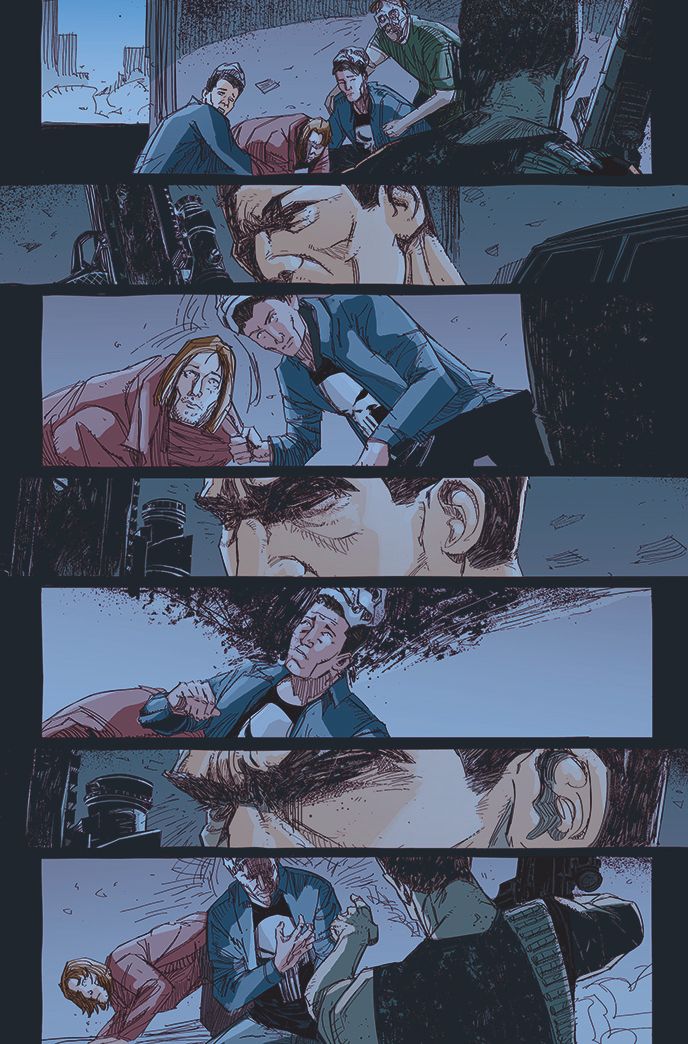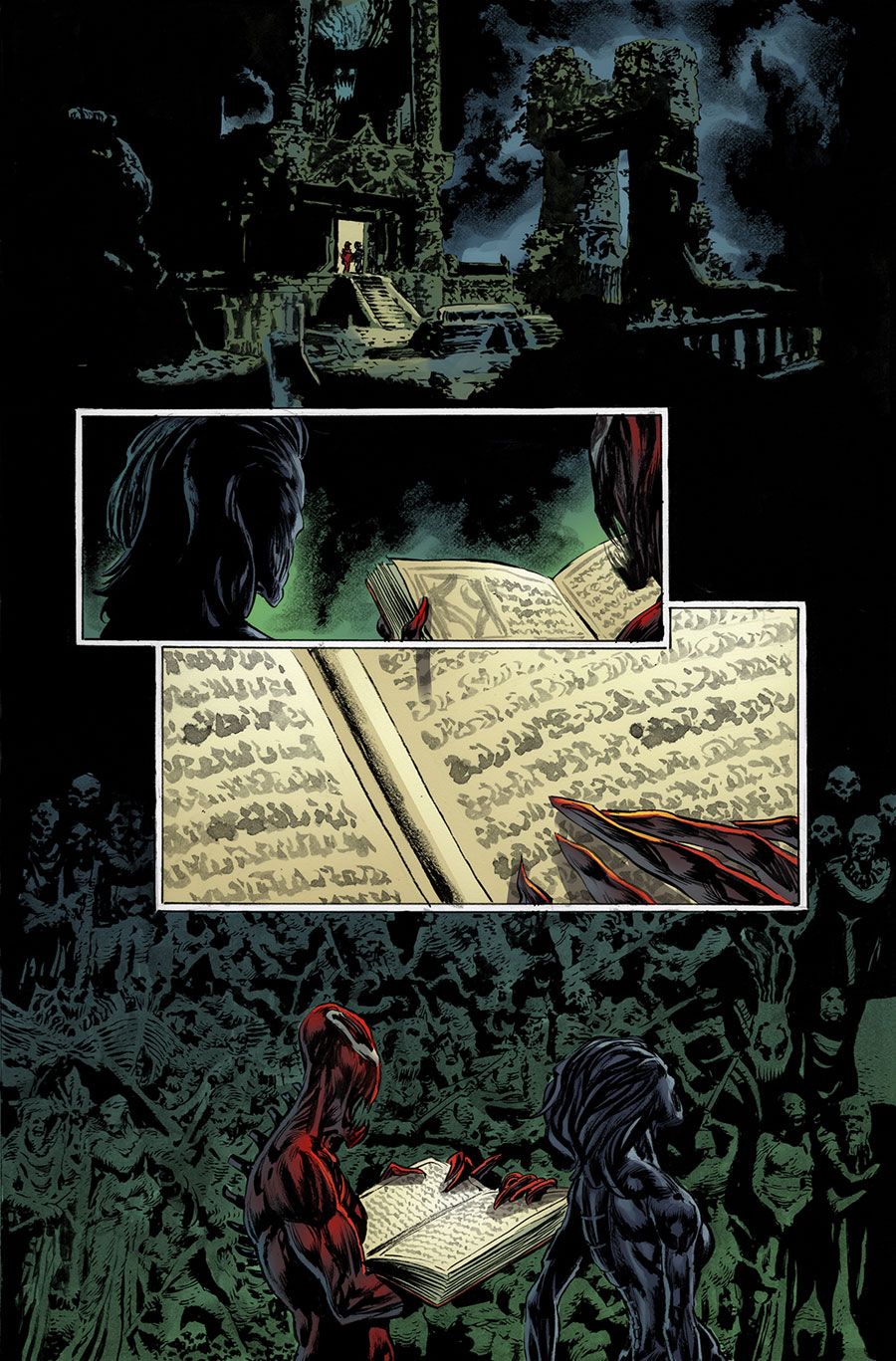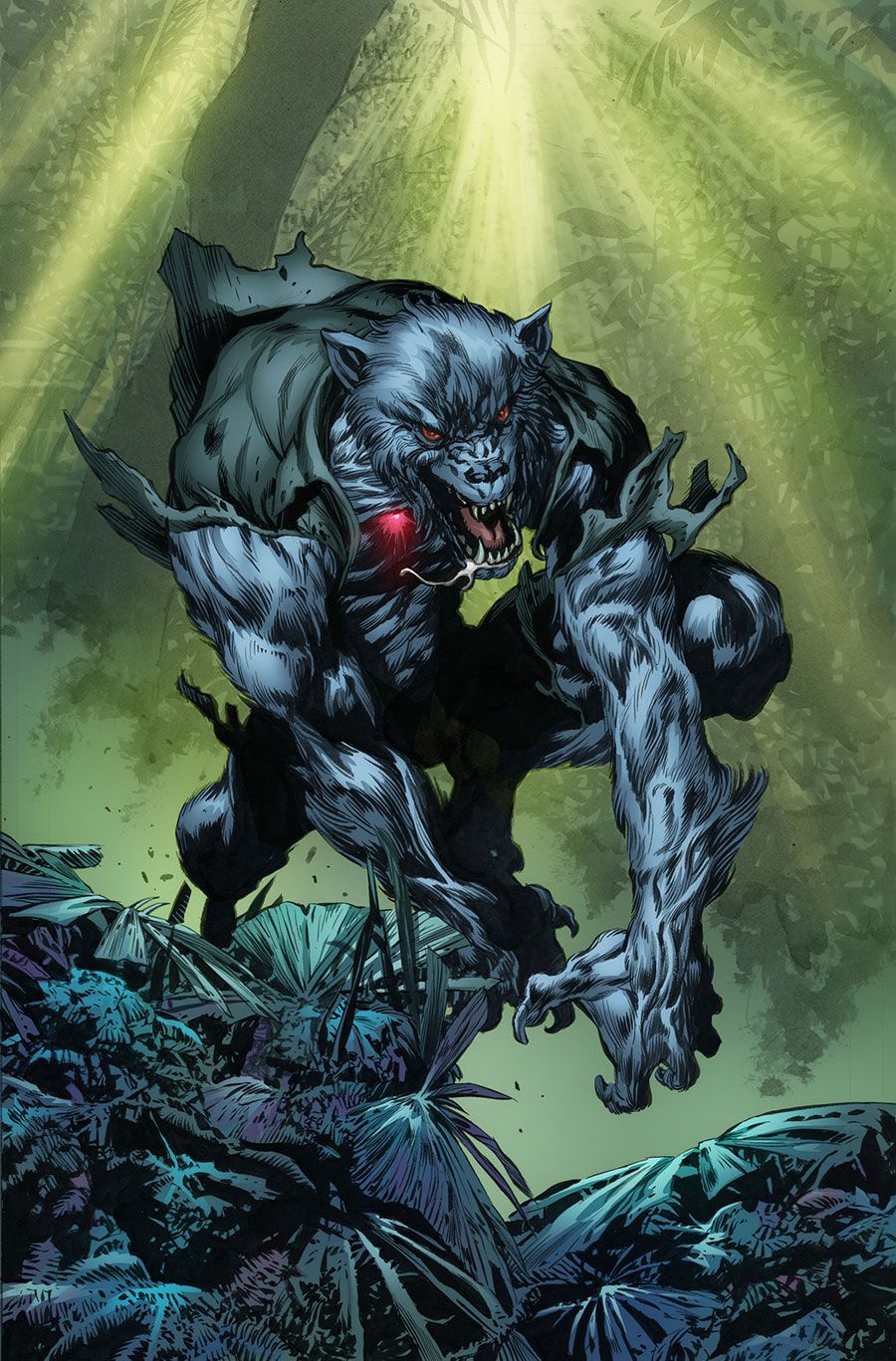Marine turned vigilante Frank Castle (AKA the Punisher) wages a one man war on organized crime while chaos worshipping serial killer Cletus Kasady (AKA Carnage) uses his super powered symbiote to hunt and prey on victims. So the two characters are wildly different, but they do share a common bond in that they're two of the Marvel Universe's consummate killers. They're also two characters writer Gerry Conway has unique insight to given that he co-created the Punisher with artist John Romita Sr. for 1974's “Amazing Spider-Man” #129, and that he currently writes an ongoing “Carnage” series, where the title character is trying to unlock the power of the mystical “Book of Sins” known as the Darkhold while being pursued by an intrepid band of heroes out to end his reign of terror.
Both of these characters have a monstrous capability for violence. So it's only fitting that in October, the month where monsters are celebrated that Conway would make his return to Frank Castle with this year's “Punisher Annual” and that the current arc of “Carnage” finds the Darkhold storyline rocketing towards an explosive climax. CBR New spoke with Conway about his take on the Punisher and the character's evolution, his Halloween set Annual, and the pulp inspirations for the current arc of Carnage which finds the cast stranded on a mysterious island and hounded by half human creatures.
CBR: Gerry, you, John Romita Sr. and Ross Andru created the Punisher back in the 1970s. How does it feel, then, to return to the character with this year's “Punisher Annual?” Do you recall the last time you wrote a Frank Castle story?
Gerry Conway: Yeah, I do. I believe it was “Punisher: Bloodlines,” a graphic novel I did with Dave Cockrum in 1991. It was an original graphic novel, like they were doing at the time, and I believe it was about a South American drug dealer and the Punisher gets involved. I don't remember a lot of the specifics, but it was an interesting project to work on because I was working with Dave, who I don't believe had drawn the character up to that point.
He had a very different style than you would have expected to see on the Punisher. So it was visually different for the time. It featured the more traditional Punisher in the white boots and black jumpsuit with the big skull. We attempted to keep it in tone with what was being done with the Punisher in the '80s, but the characters have advanced so much since then. There have been a variety of iterations and attitude changes. So coming back to the character today was more of a leap than doing that story in the early '90s.
As you mentioned, Frank has changed and evolved over the years, and his popularity has grown quite a bit. How's it been watching the character you created go from Spider-Man antagonist to one of Marvel's most popular anti-heroes?
It's fascinating. When I created the character with Ross and John, he was supposed to be just a one-shot throwaway character, but as we developed him for the issue, it became clear we had a character with more potential than that. Then, in the writing of the issue, I liked the character a lot. We planned the character's return before we even had sales figures.
We were on board with the Punisher from the start, but as he was originally written, his status as an anti-hero was much more ambiguous. He started out as somebody who was perceived to be a villain and was played as a loose cannon who could be as much a danger to Spider-Man as the other villain who would have been featured in the story.
As he's developed over the years, though, he's became a true anti-hero and a figure that represents a kind of ruthless implacable justice. As I said, that wasn't the original intention of the character. He was supposed to be more ambiguous. You weren't sure whether to root for him or not.
My wife Laura was introduced to the Punisher via Season 2 of the “Daredevil” Netflix series, and she's a huge fan of the character now, specifically, I think, because of John Bernthal's performance and how well the character was written on the show. She sees him as a completely sympathetic character, [Laughs] and he was never supposed to be a sympathetic character.
It's an interesting development, and I'm really happy it’s happened. He's a great character, but it is weird to see how far he’s come.
In recent years, Frank has been a character who readers got to know through his dialogue and inner monologues as well as a laconic, laser-focused killing machine whose actions speak much louder than his words. Which portrayal of the character interests you the most? Which version Frank Castle will appear in your “Punisher Annual?”
We're actually seeing this story from somebody else's point of view. Frank Castle is definitely the main character, but we're filtering him through somebody else's perceptions. So from the outside, he is the implacable killing machine, but his motives are complex. I like that aspect of him and I think an attribute which is always useful for a writer to explore.
One of the great things about the Punisher is that he's a Rorschach Test for the creative teams working on him. A character like Spider-Man has a motivation that is direct and unambiguous. Spider-Man is a guy who feels guilt over failing the people in his life he felt an obligation to protect. He's trying to make up for that on a daily basis. He's got great power and feels a great sense of responsibility. We know where he comes from, but with Frank Castle, we understand his motive, but the means by which he pursues his goals are means which we as a society generally do not approve. So that makes Frank a fascinating character, especially because he's self aware. At least, I think he can be.
Different writers will interpret him in different ways. Some writers have interpreted him as flat out insane, while others treat him as a broken man. Some emphasize the implacable killing machine aspect. Others explore the internal morality. All of that is valid and fascinating.
I like to explore Frank Castle’s self awareness; this is a guy who made a conscious decision to cross the line. He feels it's justified, and he also knows society would not agree with him. [Laughs] But he's okay with that. He's made his peace with it. He recognizes he's fundamentally on the outside. That to me is intriguing.
I noticed your “Punisher Annual” takes place on Halloween. What's it like writing Frank against that sort of backdrop?
It's more of a grounded, street level tale, which is the kind of story I prefer to write for that character. Halloween is about masks. It's about how we are perceived to the outside world versus how we are inside ourselves. That's the theme of our story.
Halloween as a setting also gives me opportunities to ask the artist for great visuals. We have a lot of fun showing Castle dealing with people in costume. There's one bit in particular I'm really proud of, the first idea I had when Jake Thomas, my editor, told me he wanted a story set during Halloween. It gave me an image I was happy to get into the story.
“All Souls” is also a gang story and a traditional Punisher story in many ways, but with some tweaks and turns I hope will keep the reader guessing.
Felix Ruiz is drawing it, and given his past work on the character as well as characters like Batman and Dark Circle Comics' Hangman, he seems like he'd be a great fit.
He does a great job. Ruiz has an unusual style for this character. Very angular and direct. It's another take on the character, like the Dave Cockrum take, that's perhaps not a traditional look for the Punisher. I think it works great.
The other book you're doing that got readers in the Halloween spirit is “Carnage,” which features Mike Perkins on art. What I love about that series current arc is it very much feels like a character focused old school pulp horror story set in the Marvel Universe. What inspired this current arc?
When we first started talking about doing a “Carnage” series, one of the reference points Nick Lowe and Devin Lewis, who were the editorial team at the time, mentioned was “Tomb of Dracula.” Carnage would be the focus of the stories, but what would give the book its issue to issue flavor is the supporting cast in pursuit of him.
That immediately put me back in mind to when I wrote “Tomb of Dracula,” which is also when Marvel published its 1970s solo lead horror books like “Werewolf by Night.” That in turn reminded me we have this MacGuffin in the MCU that gives us a good supernatural hook and can take us on an adventure around the world: the Darkhold; the ancient book now appearing in “Agents of S.H.I.E.L.D.” Having the Darkhold show up on “S.H.I.E.L.D.” while we’re using it in “Carnage” was pure serendipity. We started this book over a year and a half ago and I'm guessing the “S.H.I.E.L.D.” team decided use the Darkhold on their show just this spring.
Once you think of the Marvel solo-character horror books, and bring in something like the Darkhold, that opens the door to a variety of different storytelling techniques and an atmosphere unique to what Marvel is doing these days. On top of that, I'm a big fan of H.P. Lovecraft’s fiction. The Darkhold is, of course, a tribute to the Necronomicon, and that in turn opens up doors to Lovecraftian-style mythology.
My desire to write character-based stories gives me a chance to do individual issues tied into a larger story arc, but with a focus on each individual character, providing the reader with some insight into that character. Hopefully that increases the investment the reader has in these people, enough to keep reading issue to issue to see what'll happen to them next. With luck readers have come to know and love our cast, and look forward to the payoff of this particular arc as we reach the climax around issue #16.
What was it like watching Mike bring to life the island setting of this arc, and its monstrous native inhabitants?
[Laughs] It's so cool. I'm blown away by every issue Mike does. He has such a grasp of the eerie and the weird, and how to make work in a superhero universe. It's as if Graham Ingels teamed up with Neal Adams. Pretty amazing. Old school EC Horror and modern superhero action in the same frame. Just astonishing work.
You mentioned that this current arc of “Carnage” is racing towards its climax. Can you offer up any hints or teases about what me might see next? The solicits suggest you're about to dive deeper into the history of the Darkhold and the Elder God Cthon?
Not everyone is getting out of this story alive. [Laughs] I can tell you that. This brings to a climax storylines that were set in motion in issue #1. We've teased the ultimate use of the Darkhold for over a year and this is the payoff.
If you're a reader who has been following the book, this is what you've hopefully been waiting for, and if you're a reader who's new to the book this is a great time to jump in and see the most spectacular storytelling we've done to this point.
Finally, horror comics like “Carnage” aren't the only books you're working on these days. You've got the “Punisher Annual” we talked about and “Amazing Spider-Man: Renew Your Vows” series starts in November. It's clear though you have fun when you're writing horror comics. What is it about the genre that you find most enjoyable?
I love writing mood scenes; the darker the better. I like putting characters in jeopardy and it's easier to put them in jeopardy when you're doing horror.
That being said, I don't actually enjoy watching horror. [Laughs] I particularly don't like the trend horror films have taken since the “Saw” movie franchise started. To me that's not horror. That's something else. It's more visual sadism than horror.
I think horror is most effective when it's about the creeping sensation that something is happening just beyond the corner of your eye, and if you turn around and look, you'll be shocked and terrified. I love suspenseful horror. You have to build character to make that kind of horror work. You have to make readers care about the people put in those situations. So the fact they're trapped in a mine with a monster matters, and when they're alone on an island with half human creatures it's a bad situation. You can only care about those scenarios if you care about the people involved.
My interest as a writer has always been writing about characters. The more fantastic the setting and situation, the more fun it is, obviously, but horror gives me an opportunity to dig deeper into what the characters are experiencing. It’s good for me and, hopefully, good for the reader.

